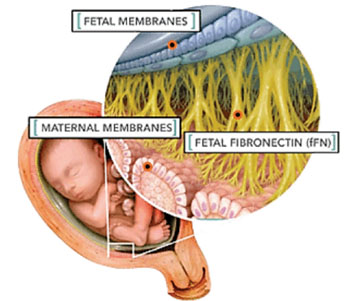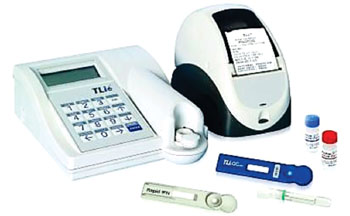Biomarker Predicts Risk of Preterm Birth Earlier
|
By LabMedica International staff writers Posted on 26 Jan 2016 |

Image: Fetal fibronectin is a “glue-like” protein that holds the developing baby in the womb (Photo courtesy of Hologic Inc.).

Image: The fetal fibronectin test system for predicting preterm labor risk (Photo courtesy of Hologic Inc.).
A standard biomarker test offered earlier in pregnancy could potentially help doctors to better identify women at risk of giving birth prematurely, thus enabling health services to focus treatments on women at highest risk.
A number of factors are used to determine if a woman is at risk of giving birth prematurely, including a history of preterm births or late miscarriages. Two further factors which clinicians normally consider are the length of cervix and levels of a biomarker found in vaginal fluid known as fetal fibronectin.
Scientists at King's College London (London, UK) compared measurements of a new fetal fibronectin test in the cervicovaginal fluid of women at 18 to 21 weeks of gestation with measurements made at 22 to 27 weeks of gestation, to see which time period offered the best prediction of spontaneous preterm birth. They also explored whether using a low (10 ng/mL) and high (200 ng/mL) threshold would more accurately classify a women's risk of giving birth prematurely.
Fetal fibronectin was measured using Hologic 10Q system (Hologic; Marlborough, MA, USA). Of the 898 high risk women followed in the study, 8.7% delivered spontaneously before 34 weeks of gestation and only 3.8% of women with concentrations less than 10 ng/mL (tested at 18–21 weeks) delivered before 34 weeks of gestation, a similar rate to that expected in a normal pregnancy. This compared to 2.9% in those tested later (22–27 weeks). In those woman over 200 ng/mL, similar proportions delivered after 34 weeks whether tested early or late (39% versus 43%).
The authors concluded that measuring fetal fibronectin at 18–21 weeks pregnancy appears to offer a similar predictive value to measurements at 22–27 weeks. For both the early and standard tests, there was a noticeable increase in relative risk between the lowest and highest thresholds used in the study. Combining cervical length with the biomarker test was found to improve the diagnostic accuracy further. Low fibronectin concentrations are associated with spontaneous preterm birthrates approaching population background levels.
Andrew A. Shennan, MD, a professor of Obstetrics and lead author of the study, said, “The aim of our study was to find better ways of establishing the risk of women giving birth prematurely in early pregnancy, to enable us to focus on the women most likely to benefit from earlier intervention and close monitoring during pregnancy. Instead of relying on the traditional single threshold later in pregnancy we now can more accurately identify those likely to be normal and those most in need of early interventions, from the first half of pregnancy.” The study was published on January 7, 2016, in the journal Obstetrics and Gynecology.
Related Links:
King's College London
Hologic
A number of factors are used to determine if a woman is at risk of giving birth prematurely, including a history of preterm births or late miscarriages. Two further factors which clinicians normally consider are the length of cervix and levels of a biomarker found in vaginal fluid known as fetal fibronectin.
Scientists at King's College London (London, UK) compared measurements of a new fetal fibronectin test in the cervicovaginal fluid of women at 18 to 21 weeks of gestation with measurements made at 22 to 27 weeks of gestation, to see which time period offered the best prediction of spontaneous preterm birth. They also explored whether using a low (10 ng/mL) and high (200 ng/mL) threshold would more accurately classify a women's risk of giving birth prematurely.
Fetal fibronectin was measured using Hologic 10Q system (Hologic; Marlborough, MA, USA). Of the 898 high risk women followed in the study, 8.7% delivered spontaneously before 34 weeks of gestation and only 3.8% of women with concentrations less than 10 ng/mL (tested at 18–21 weeks) delivered before 34 weeks of gestation, a similar rate to that expected in a normal pregnancy. This compared to 2.9% in those tested later (22–27 weeks). In those woman over 200 ng/mL, similar proportions delivered after 34 weeks whether tested early or late (39% versus 43%).
The authors concluded that measuring fetal fibronectin at 18–21 weeks pregnancy appears to offer a similar predictive value to measurements at 22–27 weeks. For both the early and standard tests, there was a noticeable increase in relative risk between the lowest and highest thresholds used in the study. Combining cervical length with the biomarker test was found to improve the diagnostic accuracy further. Low fibronectin concentrations are associated with spontaneous preterm birthrates approaching population background levels.
Andrew A. Shennan, MD, a professor of Obstetrics and lead author of the study, said, “The aim of our study was to find better ways of establishing the risk of women giving birth prematurely in early pregnancy, to enable us to focus on the women most likely to benefit from earlier intervention and close monitoring during pregnancy. Instead of relying on the traditional single threshold later in pregnancy we now can more accurately identify those likely to be normal and those most in need of early interventions, from the first half of pregnancy.” The study was published on January 7, 2016, in the journal Obstetrics and Gynecology.
Related Links:
King's College London
Hologic
Latest Clinical Chem. News
- Carbon Nanotubes Help Build Highly Accurate Sensors for Continuous Health Monitoring
- Paper-Based Device Boosts HIV Test Accuracy from Dried Blood Samples
- AI-Powered Raman Spectroscopy Method Enables Rapid Drug Detection in Blood
- Novel LC-MS/MS Assay Detects Low Creatinine in Sweat and Saliva
- Biosensing Technology Breakthrough Paves Way for New Methods of Early Disease Detection
- New Saliva Test Rapidly Identifies Paracetamol Overdose
- POC Saliva Testing Device Predicts Heart Failure in 15 Minutes

- Screening Tool Detects Multiple Health Conditions from Single Blood Drop
- Integrated Chemistry and Immunoassay Analyzer with Extensive Assay Menu Offers Flexibility, Scalability and Data Commutability
- Rapid Drug Test to Improve Treatment for Patients Presenting to Hospital
- AI Model Detects Cancer at Lightning Speed through Sugar Analyses
- First-Ever Blood-Powered Chip Offers Real-Time Health Monitoring
- New ADLM Guidance Provides Expert Recommendations on Clinical Testing For Respiratory Viral Infections
- 3D Printed Point-Of-Care Mass Spectrometer Outperforms State-Of-The-Art Models
- POC Biomedical Test Spins Water Droplet Using Sound Waves for Cancer Detection
- Highly Reliable Cell-Based Assay Enables Accurate Diagnosis of Endocrine Diseases
Channels
Molecular Diagnostics
view channel
Highly Accurate Blood Test Diagnoses Alzheimer’s and Measures Dementia Progression
Several blood tests are currently available to assist doctors in diagnosing Alzheimer's disease in individuals experiencing cognitive symptoms. However, these tests do not provide insights into the clinical... Read more
Simple DNA PCR-Based Lab Test to Enable Personalized Treatment of Bacterial Vaginosis
Approximately one in three women aged 14-49 in the United States will experience bacterial vaginosis (BV), a vaginal bacterial imbalance, at some point in their lives. Around 50% of BV cases do not present... Read moreHematology
view channel
New Scoring System Predicts Risk of Developing Cancer from Common Blood Disorder
Clonal cytopenia of undetermined significance (CCUS) is a blood disorder commonly found in older adults, characterized by mutations in blood cells and a low blood count, but without any obvious cause or... Read more
Non-Invasive Prenatal Test for Fetal RhD Status Demonstrates 100% Accuracy
In the United States, approximately 15% of pregnant individuals are RhD-negative. However, in about 40% of these cases, the fetus is also RhD-negative, making the administration of RhoGAM unnecessary.... Read moreImmunology
view channel
Post-Treatment Blood Test Could Inform Future Cancer Therapy Decisions
In the ongoing advancement of personalized medicine, a new study has provided evidence supporting the use of a tool that detects cancer-derived molecules in the blood of lung cancer patients years after... Read more
Cerebrospinal Fluid Test Predicts Dangerous Side Effect of Cancer Treatment
In recent years, cancer immunotherapy has emerged as a promising approach where the patient's immune system is harnessed to fight cancer. One form of immunotherapy, called CAR-T-cell therapy, involves... Read more
New Test Measures Preterm Infant Immunity Using Only Two Drops of Blood
Preterm infants are particularly vulnerable due to their organs still undergoing development, which can lead to difficulties in breathing, eating, and regulating body temperature. This is especially true... Read more
Simple Blood Test Could Help Choose Better Treatments for Patients with Recurrent Endometrial Cancer
Endometrial cancer, which develops in the lining of the uterus, is the most prevalent gynecologic cancer in the United States, affecting over 66,000 women annually. Projections indicate that in 2025, around... Read moreMicrobiology
view channel
Breakthrough Diagnostic Technology Identifies Bacterial Infections with Almost 100% Accuracy within Three Hours
Rapid and precise identification of pathogenic microbes in patient samples is essential for the effective treatment of acute infectious diseases, such as sepsis. The fluorescence in situ hybridization... Read more
Innovative ID/AST System to Help Diagnose Infectious Diseases and Combat AMR
Each year, 11 million people across the world die of sepsis out of which 1.3 million deaths are due to antibiotic-resistant bacteria. The burden of antimicrobial resistance (AMR) continues to weigh heavily,... Read more
Gastrointestinal Panel Delivers Rapid Detection of Five Common Bacterial Pathogens for Outpatient Use
Acute infectious gastroenteritis results in approximately 179 million cases each year in the United States, leading to a significant number of outpatient visits and hospitalizations. To address this, a... Read morePathology
view channel
New Laser-Based Method to Accelerate Cancer Diagnosis
Researchers have developed a method to improve cancer diagnostics and other diseases. Collagen, a key structural protein, plays various roles in cell activity. A novel multidisciplinary study published... Read more
New AI Model Predicts Gene Variants’ Effects on Specific Diseases
In recent years, artificial intelligence (AI) has greatly enhanced our ability to identify a vast number of genetic variants in increasingly larger populations. However, up to half of these variants are... Read more
Powerful AI Tool Diagnoses Coeliac Disease from Biopsy Images with Over 97% Accuracy
Coeliac disease is an autoimmune disorder triggered by the consumption of gluten, causing symptoms such as stomach cramps, diarrhea, skin rashes, weight loss, fatigue, and anemia. Due to the wide variation... Read moreTechnology
view channel
Smartphones Could Diagnose Diseases Using Infrared Scans
Rapid advancements in technology may soon make it possible for individuals to bypass invasive medical procedures by simply uploading a screenshot of their lab results from their phone directly to their doctor.... Read more
Novel Sensor Technology to Enable Early Diagnoses of Metabolic and Cardiovascular Disorders
Metabolites are critical compounds that fuel life's essential functions, playing a key role in producing energy, regulating cellular activities, and maintaining the balance of bodily systems.... Read more
3D Printing Breakthrough Enables Large Scale Development of Tiny Microfluidic Devices
Microfluidic devices are diagnostic systems capable of analyzing small volumes of materials with precision and speed. These devices are used in a variety of applications, including cancer cell analysis,... Read moreIndustry
view channel
Philips and Ibex Expand Partnership to Enhance AI-Enabled Pathology Workflows
Royal Philips (Amsterdam, The Netherlands) has expanded its partnership with Ibex Medical Analytics (Tel Aviv, Israel) and released the new Philips IntelliSite Pathology Solution (PIPS) to further accelerate... Read more
Grifols and Inpeco Partner to Deliver Transfusion Medicine ‘Lab of The Future’
Grifols (Barcelona, Spain), a manufacturer of plasma-derived medicines and innovative diagnostic solutions, has entered into a strategic agreement with Inpeco (Novazzano, Switzerland), a global leader... Read more



















